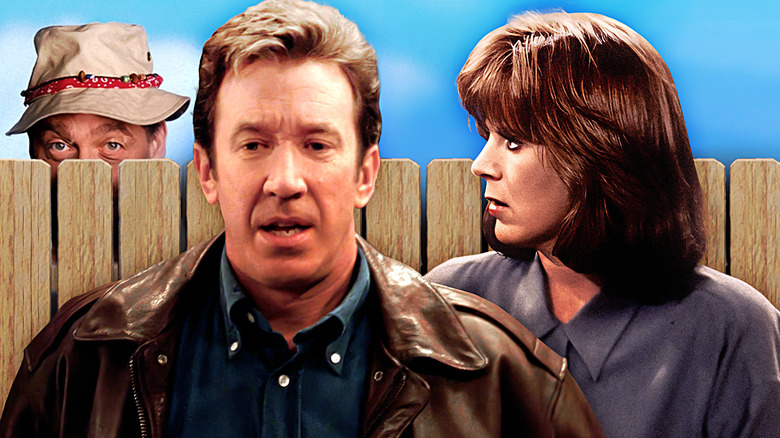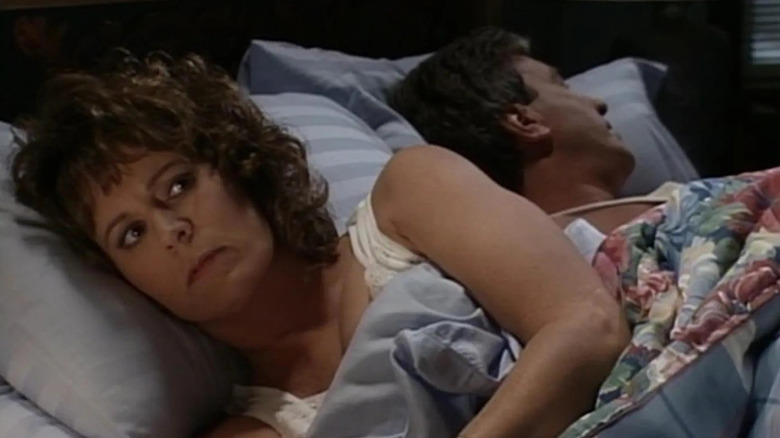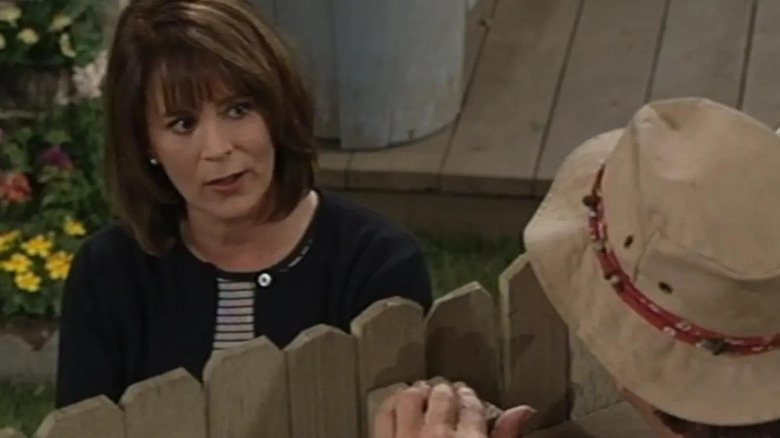If you were around in the ’90s, you probably grew up hearing the familiar “Huh?!” sound of the decade’s long-running sitcom “Home Improvement.” Love it or hate it, the Tim Allen-led show about the Taylor family, led by overconfident Tim The Toolman, was pretty ubiquitous throughout its eight-season run, and it even won seven Primetime Emmys. But at some point in 1999, the show faded out and the “Huh?!” sound stopped popping up in primetime. It left behind a legacy that included Jonathan Taylor Thomas, the often-unseen nosy neighbor Wilson, and Tim Allen’s alleged bad behavior and on-the-record terrible opinions.
Just in 2024, another layer was added to the show’s legacy when co-star Patricia Richardson, who played Tim’s long-suffering wife Jill, spoke to the Los Angeles Times about the 25th anniversary of the show’s final season, revealing that a pay dispute ultimately led to the series demise. Like so many sitcoms that came before and after it, from “Seinfeld” to “Friends” to “The Big Bang Theory,” pay negotiations played a part in the show’s plans for future seasons. In this case, though, Richardson says she wanted to leave the series late in its run, and studio executives’ apparent unwillingness to remedy a huge gender pay gap sealed the deal.
Home Improvement had a pay gap issue behind the scenes
“Home Improvement” aired on ABC and debuted before its parent company merged with Disney, but it was also produced by the Disney-owned Touchstone Television. Richardson was under contract with Disney when she started playing Jill on the series, and she told the LA Times that she gave regular creative input behind the scenes on the show. According to Richardson and writer/co-executive producer Rosalind Moore, Richardson would push back against some of the show’s script decisions (which were primarily made by men), helping to form a richer character for herself in the process. This reportedly wasn’t unusual for the series either, as she and Allen would both typically give feedback to writers and producers at read-throughs.
However, despite her influence on the series, Richardson said she was never given the producer credit she asked for. (Allen, meanwhile, executive produced 77 episodes of the show.) According to Richardson, the explanation she was given was that if she got the credit, other actors would want one as well. Still, she was able to hold her own in negotiations, scoring a profit share point and a guarantee of four episodes focused on her character per season during contract renegotiations in 1993. According to Richardson, though, she consistently made less than a third of Allen’s salary throughout the show’s run.
Fast forward a few years, and Richardson was ready to leave the series. “I told everybody, there’s not enough money in the world to get me to do a ninth year. This show is over. It needs to end,” she told the LA Times. Between Richardson wanting to spend more time with her family, an influx of new directors, and Thomas’ exit, the job just wasn’t the same for her. ABC clearly really wanted another season, though (“Home Improvement” appears to have been a consistent ratings hit), and offered Allen $2 million per episode for 25 more episodes, according to Richardson. Meanwhile, she got offered $1 million per episode — a very hefty sum, but still half of her co-star’s offer. This is a frustratingly common problem that many, many women have spoken out about. In 2017, Natalie Portman summed it up by telling The Guardian, “Compared to men, in most professions, women make 80 cents to the dollar. In Hollywood, we are making 30 cents to the dollar.”
Patricia Richardson was ready to leave Home Improvement, and Disney made it easy
Richardson countered the expected but frustrating lowball with her own proposal: $2 million dollars per episode and an executive producer credit — the same things Allen already had or was now being offered. “I knew that Disney would in no way pay me that much. That was my way to say ‘no’ and was a little bit of a flip-off to Disney,” Richardson explained. “I’d been there all this time, and they never even paid me a third of what Tim was making, and I was working my ass off. I was a big reason why women were watching.” She was right. The offer was rejected, and in what was perhaps a backwards testament to how important her role on the show was, apparently no one really considered continuing “Home Improvement” without Richardson.
Though they reunited for the TV show “Last Man Standing,” it sounds like Allen and Richardson’s relationship was complicated by her taking a stand for herself in negotiations, especially because Allen had already said yes to the deal. “I was mad at Tim because he was leaving me alone being the only person saying no, which made me feel terrible and like the bad guy,” she explained, “and he was upset with me for leaving.” Weirdly, art would imitate life in the series finale of “Home Improvement,” when Tim was offered a raise and executive producer credit to keep making his show “Tool Time,” but ultimately turned it down to allow Jill to follow her dream of working as a child psychologist in Indiana.
It’s a sweet conclusion to a show that didn’t always put its female lead — the glue holding its fictional family together — first. It’s just a shame that the real gender politics at play behind the scenes were a lot messier than the Taylor family’s happy ending.










